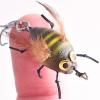-
Posts
58 -
Joined
-
Last visited
About Dave Rennie
- Birthday 01/14/1978
Profile Information
-
Location
Milton Keynes - UK
-
Interests
Fishing, making fishing tackle, music, movies, cooking, eating & drinking.
Dave Rennie's Achievements
Newbie (1/14)
0
Reputation
-
Thanks Benno, It sounds great, but expensive:) I'd like to have a go at 3d modelling in the future. Need to make my fortunes first though. Dave
-
Just thought I'd update this thread. The blank has arrived. First impressions are that it's going to work a treat. It's very thin. Fast. Strong. Light. Not at all what I considered a fly rod to feel like. It has the same aesthetics as another rod that I've got that is built on a Toray blank. It looks plain until the sun hits it, then all of the beauty of the carbon is revealed. I'm looking forward to getting started.
-
Your printing set up sounds interesting Benno. What set up are you using, and what kind of costs are involved? Thanks Dave
-
Very nice baits there Travis! I started with modelling clay a few months ago. I started with Steadtler fimo soft, but now use Steadtler fimo classic as it's much firmer to work with (but you have to kneed it properly before you start working with it). Once it's been baked it sands nicely. I've had a lot of fun so far with top pour molds and will soon have a go at 2 part molds. There's a few that I'm really happy with the action of. Here are a few baking tips that I've learnt along the way. 1. Bake for longer than the clay manufacturer recommends. Fimo clay is recommended for 30 mins at 110c. I give it an hour. The reason for this is that it bakes harder and is less flexible when finished. 2. Before going into the oven, put the lures on a piece of paper and onto a ceramic tile or plate, then put a metal pan over the lures. The paper stops the part of the lure that touches the tile/plate from turning glossy. The pan keeps the heat around the lure consistent. 3. Heat the oven once the lures are inside, and leave the lures inside for an hour after you switch the oven off. This brings the temp around the lure up and down gently, and helps avoid cracking in the clay (which can spoil a lure master). Good luck. Dave EDIT: Another reason I prefer Fimo Classic is that it's easier to make the lure very smooth while it's still unbaked. You can rub marks and finger prints out with your finger. This will save you time smoothing after it's baked. It's lovely stuff!
-
That's a LOT of cork! But a great discovery. What ratio are you using to resin? Has anyone tried mixing it with plastisol?
-
Thanks Joe, I’ll give the dry whipping/tape combo a go. I think I'll stick with braid on this outfit actually. I have PP on my other outfits and much prefer it over mono. I've got a busy work schedule for the coming month or so, but I'm itching to getting started with this project when I’ve got the time. The blank has been shipped today, and I’ve got a good idea for components I’ll use for the rest of the build. Firstly I’m going to make a modular table top work station that will switch between a hand wrapper, a rod dryer (using a mirror ball motor) and a mini lathe (using a drill). Yes this is going to be lots of fun! For the last year or so I’ve been fishing exclusively with lures that I’ve made myself. It’s a real pleasure to catch with tackle you’ve knocked up. Fishing on a rod that I’ve built will enhance the satisfaction. I’ve already got plans for my next rod builds. The second will be a very light drop shot rod for bank fishing with switchable tips, then a heavy lure rod for pike (around 50-150g CW). Both these new outfits will open up new avenues for future lure creations.
-
Catch and release has gone one ethical step further here in the UK
-
Thanks Bob, I did the method you mentioned with a spinner wire through the eye of the jig hook. That part worked fine. The problem I had was that the lure spun in the water rather than swimming straight. I think this was because the weight was positioned to the top / middle of the lure rather than directly in front or at the belly. This was a quick test with thin lead window strip wrapped around a jig hook. In all fairness I didn't have time to test the lure with a shop bought ball jig head, so I have no idea how the lure performs yet. What I want to achieve is pouring my own jig heads with lead, then inserting them into a multi cavity two part lure mold so the jig hooks are concealed.
-
I know what you're saying, but I'd rather have my jig heads either part of the lure design (fish skull), or contained within the lure itself. I'm swaying more towards having the lead part of the jig head contained within the lure, I just want to figure out how to do this properly to make sure the lures swim straight and not spin like one did on a recent test with a top pour mold. Some of the lures I've made are tiny like a 1" Kopyto. In order to put 1.5g of lead in the head of the body, I need the lead to be slim and long, rather than a ball that protrudes out of the plastic. I need to make the mold for the jig heads before I make the mold for the plastics.
-
Thanks Cub, That's a good idea. I'll be trying the wooden dowel idea like JR suggested first, as it looks simple. There's a Paul Adams video on YouTube using the same method, and he wraps the end of the dowel in aluminium foil to prevent burning. I've got a nice design drawn up for the mold now that will hopefully fill all the cavities, I've already made about 10 masters from polymer clay, but have changed my mind on the jig heads that I was going to have in place the mold at time of pouring. I need a bit of advise on this and will start a new thread soon.
-
Hi Joe, Thanks again for your continued help on this. I really appreciate it. I spoke again with Mick today after he'd read our conversation. I've ordered a blank! I've gone for the 5wt, as Mick says the 5 is considerably faster than the 6 he stocks (waggle is the enemy) and he assures me it will be plenary strong enough for the bigger end fish in my ponds. He's offered to exchange the blank for a 6 if I'm not happy with it. So, things are moving. Thanks for the tip with the masking tape layout for guides and ferrules, great idea. Rather than dry whipping the guides for testing, could I use insulation tape instead? I will go for the Microwave system, as I'll regret it later if I don't. Even if it only gives me an extra few feet, it'll be worth having (and good to try them out before I start on my 2nd rod project). Seems they aren't available here in the UK, so these may take a week or two to arrive from the States once I figure out which set to buy. Now I can start ordering the other bits and bobs that I'll be need to turn Dave's Supercalafragalistic Surface Sniper into a reality. I'll keep this thread up to date throughout the process.
-
Hi Joe, Everything you said above makes perfect sense. I want a blank that has quite a fast recovery, but that becomes soft when setting the hook. As you mentioned in another post regarding it not always being the case that softer tips will cast the furthest. From my own limited experience, a 9'6" ledger rod cast the dog biscuit the furthest, and that had a stiffer tip than any other rods I tried for this purpose. However, it was slightly too stiff for setting the hook. Ideally I want to tick both of these boxes. Anyway, a quick update. I've contacted UK based blank dealer/rod builder regarding this project named Mick Bell. His company is called Bloke Rods and he's very well renowned. He’s recommended a 10' 4pc Toray 50 million modulus in a 4 weight, which Mick describes as parabolic with middle to tip action on the fast side. I've sent him snippets of our conversation regarding recommended rod weights of 6-7wt, and your reasons for recommending that weight for my intended purpose, and he's going to read over it and get back to me. Here’s the 4wt that Mick has recommended: http://www.ebay.co.uk/itm/291553770108?_trksid=p2055119.m1438.l2649&ssPageName=STRK%3AMEBIDX%3AIT Here’s the 6wt that I’m considering: http://www.ebay.co.uk/itm/291553769261?_trksid=p2055119.m1438.l2649&ssPageName=STRK%3AMEBIDX%3AIT Today I was in a tackle shop and had a quick waggle of a Ron Thompson 9’ 2pc 7-8wt. I was amazed at how fast the action was compared to fly rods I remember holding years ago! My mind is made up. I’m just waiting to hear back from Mick (and from yourself if you’ve got any feedback on the blanks I’ve mentioned above). Regarding guides, I've been reading up on the microwave system and want to give that a go. I see you've got 10 guides on your 9' rod (the photo of your rod lay on the floor), so would 11 guides be advised for a 10' rod, in similar placing as in your photo? You say you go down on size fast from 16mm - 6, but suggested slightly bigger if I was using mono? Do you have any idea which size microwave guides would work best with the set up I'm planning? Thanks again for your help. It’s great to hear from someone who understands what I want to achieve and has been there themselves. Dave
-
Great finding Mountain Man, I've also considered using cork dust for other lure projects like you mentioned. I have a bag of it and use it for covering countersunk weights in fake dog biscuit baits. I'd love to see some pics. You can upload them to postimage.org, and then copy and paste the URL into your post. Like this. (Sorry, copy the one above "Thumbnail for forums (1)")




